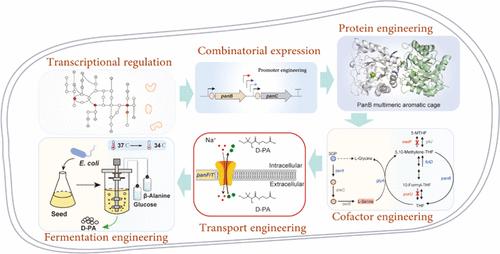通过改造酮泛酸羟甲基转移酶和辅因子供应,在大肠杆菌中高效合成维生素 B5
IF 6.2
1区 农林科学
Q1 AGRICULTURE, MULTIDISCIPLINARY
引用次数: 0
摘要
d-泛酸(d-pantothenic acid, d-PA),又称维生素B5,是辅酶A的重要前体,在维持生物体的生理功能中起着至关重要的作用。酮托酸羟甲基转移酶(Ketopantoate hydroxymethyltransferase, PanB)是d-PA合成的关键限速酶,由PanB基因编码。此外,PanB的催化功能需要辅因子5,10-亚甲基四氢叶酸(5,10- ch2 - thf)。本研究旨在通过改造酮托酸羟甲基转移酶和辅助因子的供应来增加d-PA的产量。通过转录因子工程技术筛选和鉴定了限制d-PA生成的关键转录因子bhsA。随后,PanB与PanC共表达以调控表达。此外,通过Km/Kcat算法预测和酶工程产生了高催化突变体PanBMV123I/K124W,使d-PA产量增加2.5倍。5,10- ch2 - thf的从头合成途径增强,而其降解途径被抑制以改善辅因子的供应。然后,通过引入来自中间链球菌的d-PA转运体PanT,增强了d-PA的细胞外转运。无质粒菌株DPA23在5-L生物反应器中产d-PA 78.48 g/L, 24 h产率为2.69 g/L/h,葡萄糖产率为0.54 g/g。这些策略为构建d-PA及其衍生物的微生物细胞工厂提供了参考。本文章由计算机程序翻译,如有差异,请以英文原文为准。

Efficient Synthesis of Vitamin B5 in Escherichia coli by Engineering Ketopantoate Hydroxymethyltransferase and Cofactor Supply
d-pantothenic acid (d-PA), also known as vitamin B5, is an essential precursor of coenzyme A and plays a crucial role in maintaining the physiological functions of organisms. Ketopantoate hydroxymethyltransferase (PanB), encoded by panB gene, serves as a key rate-limiting enzyme in d-PA synthesis. Additionally, the catalytic function of PanB requires the cofactor 5,10-methylenetetrahydrofolate (5,10-CH2–THF). This study aimed to increase d-PA production by engineering ketopantoate hydroxymethyltransferase and cofactor supply. The key transcription factor bhsA that restricts d-PA production was screened and identified through transcription factor engineering applications. Subsequently, PanB was coexpressed with PanC to regulate expression. Furthermore, the highly catalytic mutant PanBMV123I/K124W was generated through Km/Kcat algorithm prediction and enzyme engineering, leading to a 2.5-fold increase in d-PA production. The de novo synthesis pathway of 5,10-CH2–THF was enhanced, whereas its degradation pathway was suppressed to improve cofactor supply. Then, the extracellular transport of d-PA was enhanced by introducing the d-PA transporter PanT from Streptococcus intermedius. The plasmid-free strain DPA23 produced 78.48 g/L of d-PA in a 5-L bioreactor, with a productivity of 2.69 g/L/h after 24 h and a glucose yield of 0.54 g/g. These strategies provided a reference for constructing microbial cell factories for d-PA and its derivatives.
求助全文
通过发布文献求助,成功后即可免费获取论文全文。
去求助
来源期刊
CiteScore
9.90
自引率
8.20%
发文量
1375
审稿时长
2.3 months
期刊介绍:
The Journal of Agricultural and Food Chemistry publishes high-quality, cutting edge original research representing complete studies and research advances dealing with the chemistry and biochemistry of agriculture and food. The Journal also encourages papers with chemistry and/or biochemistry as a major component combined with biological/sensory/nutritional/toxicological evaluation related to agriculture and/or food.

 求助内容:
求助内容: 应助结果提醒方式:
应助结果提醒方式:


